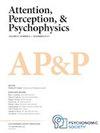Spatial selectivity in visual detection suffers when attention is divided
Abstract
Humans are not perfect at selectively responding to one stimulus while ignoring others visible at the same time. In spatial filtering tasks, this imperfect selectivity is often measured by how the judgment of the relevant stimulus depends on whether an irrelevant stimulus is associated with the same response. Such congruency effects decline with increasing spatial separation between stimuli and are minimal for widely separated stimuli. However, there is evidence that divided attention can increase congruency effects even for widely separated stimuli. We investigated this possibility for a pair of widely separated stimuli and a simple yes/no detection task. Performance was measured for a single task (only one of the stimuli was task-relevant) and for a dual task (both of the stimuli were task-relevant). In the single task there were small congruency effects, whereas in the dual task larger congruency effects occurred despite the widely separated stimuli. Results from a second experiment with sequential and simultaneous presentations were consistent with the congruency effect being due to later processes such as memory or decision rather than immediate processes such as perception. Additional results comparing high and low performance levels were consistent with congruency effects being due to a graded process such as attenuation or crosstalk rather than an all-or-none process such as blocking or substitution. These results rule out many possible theories of spatial selectivity. Our working hypothesis is that spatial selection can protect against interactive processing of multiple stimuli for a single task but not for dual tasks.

 求助内容:
求助内容: 应助结果提醒方式:
应助结果提醒方式:


